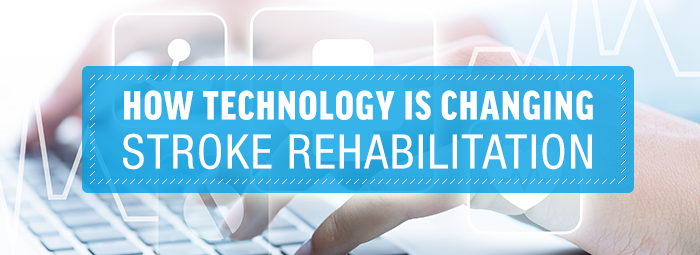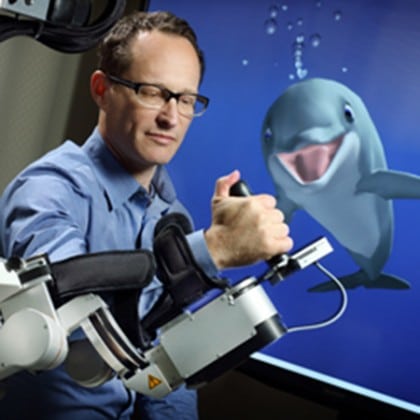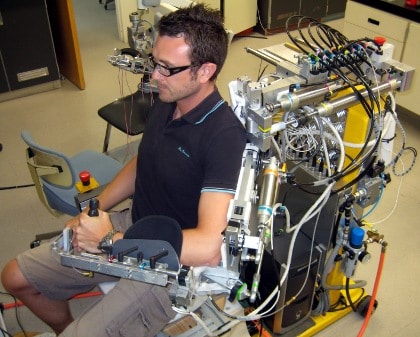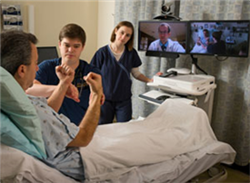How Technology Is Changing Stroke Rehabilitation

While everyday objects like clothespins and cups still play crucial roles in most patients' journeys toward recovery, new technology is constantly changing the rehabilitation game. From video chats with doctors to robotic gloves and interactive video games, stroke recovery and rehabilitation tools have come a long way in the past decade. This new stroke recovery technology is helping link neuroplasticity and learning. A key part in recovery from a stroke.
This new stroke technology gives patients more repetitions, practice time and intensity compared to previous movement trainings. Not to mention this new technology is also more interactive, attention grabbing and really helps motivate the patient. These new technologies are really helping harness the brain’s ability to repair itself in ways that haven’t been seen before.
How Technology Kick-Starts Stroke Recovery
Just like the simple exercises that caregivers have used for years, the latest stroke recovery tools revolve around the concept of neuroplasticity. Though researchers have known about the brain's ability to "retrain" itself for years, they now understand how crucial it is to begin this process as early as possible. That's because the destruction of brain tissue during stroke is actually a temporary trigger for the rest of the brain.
"The tissue death that results from stroke appears to trigger a self-repair program in the brain," says Karen Russell from The New Yorker.
After stroke, healthy brain tissue reverts to a more malleable stage for one to three months. Neuroplasticity allows healthy brain tissue to create new connections to the affected muscles and nerves for years, but during these early months of recovery, the brain is especially open to forming these connections. Unfortunately, this is also when patients' bodies face their most extreme limitations, preventing them from taking full advantage of their healthy brain tissue's malleability.

That's where modern technology comes in. Today's stroke survivors have more recovery options than ever before, and many of them are designed to capitalize on this early recovery stage. Others allow doctors and caregivers to closely monitor patients' progress and prevent common complications as they regain movement and retrain their brains in the months and years following stroke.
Video Games for Stroke Survivors
Perhaps one of the most innovative and exciting examples of stroke rehabilitation technology is in the video game space. Traditional low-tech stroke therapy options can be difficult and repetitive, making it less likely that patients follow through at home. Doctors are already noticing that video games are more engaging, exciting, and easy to incorporate into an at-home healing regimen.
One example of a new emerging video game gear toward stroke recovery is Bandit's Shark Showdown. This is an interactive video game that allows players to control an animated dolphin’s movements. The version for stroke survivors incorporates a robotic sling, which patients wear to control the shark. This simulation synchronizes patients' muscle movements with the dolphin's leaps and dives, stimulating their brain and body simultaneously.

(Source: Hub)
When you consider the brain itself, it's not so unusual that a video game could recreate and reconnect key functions. John Krakauer, a neurologist who co-created the video game with a handpicked think tank, reminded The New Yorker that every simple muscle movement "requires an incredibly sophisticated set of computations". His shark game is designed to break down "the physical-mental distinction" and restore function to impaired limbs.
"There's no right and wrong when you're playing as a dolphin," John Krakauer told The New Yorker. "You're learning the ABCs again—the building blocks of action. You're not thinking about your arm's limitations. You're learning to control a dolphin. In the process, you're going to experiment with many movements you'd never try in conventional therapy."
Another example of this is a new therapeutic device that NYU Langone Medical Center has developed that creates an interactive canoe trip. Though the video game and device is still in the early stages of development and testing, doctors from NYU Langone say that they are seeing patients be more motivated and engaging that with current standard therapies. They also have shown to be another promising therapeutic option for stroke survivors who are too injured for traditional therapy.
Similar to the NYU Langone Medical Center’s device is the SaeboReJoyce workstation. Saebo’s ReJoyce workstation is a computerized task-oriented training system that involves a range of activity-based games that test speed, endurance, coordination, range of motion, strength, timing and cognitive demand. This helps patients practice repetitive gross motor and fine motor tasks with fun and motivating activities.
Because the games are customizable and incorporate a wide variety of grasp patterns, this workstation is useful for patients at each stage of recovery.

Robotics
Among the newest therapeutic tools used for stroke victims, those most commercially available are robotics and robotic exoskeletons, which attach directly to the affected part of the body to facilitate or enable movement. Therapeutic robotic devices include leg and arm supports that actually lift and support the limbs while reorganizing the pathways between the muscles, nerves, and healthy brain tissue. Like the robotic arm sling that researchers integrated into Bandit's Shark Showdown robotic arm and leg devices contain sensors that track the limbs' movements and monitor changes in force and terrain.

(Source: Bio Robotics)
The Wall Street Journal explains that robotic exoskeletons are especially useful because they are adjustable. As patients need less support, their therapists may adjust the robotic devices to let the patients' muscles gradually resume more control. Because these exoskeletons can actually move the patients' affected limbs until they regain movement, caregivers spend less time doing this themselves. When caregivers are free to observe patients' movements – instead of manually moving their limbs – they can pay closer attention to the quality of each movement.
Body Weight Support Systems
Robots aren't the only options for patients who need extra support for weak or paralyzed limbs. Because the force of gravity can turn patient's' own body weight into an obstacle, some of the most useful recovery devices like the SaeboMAS are designed to counteract this force. Support systems designed for the arms, legs and overall body, help support and facilitate movement to make task-oriented exercises possible. Motion that this is a much more affordable option as well.

Support systems like the SaeboMAS aren't used just to speed up the therapy process. One study found that stroke survivors who receive extra weight support actually walk better than patients who must support their own weight during rehabilitation. This makes sense, because gait training is more effective when patients are able to move their joints and muscles more quickly after stroke.
Neuromuscular Electrical Stimulation
Our everyday voluntary movements are made possible by connections between the brain and the body's nerves, but after this connection is severed due to stroke, the affected nerves and muscles can no longer send or receive the sensory stimulation necessary to move. This is where neuromuscular electrical stimulation can be helpful. Neuromuscular electrical stimulation applies small electrical pulses to paralyzed muscles to restore or improve their function.

Devices like the SaeboMyoTrac Infiniti uses EMG Triggered Stimulation which is a combination of biofeedback and electrical stimulation. Stimulation by devices like these are triggered to the desired muscle group (i.e., finger extensors, elbow extensors etc.) once the client deactivates or relaxes the opposite spastic muscle group (i.e., spastic finger flexors, elbow flexors etc.)
With Sensory Electrical Stimulation (SES), it is believed to enhance the neural plasticity and activate brain areas, helping with stroke rehabilitation. Studies show that providing SES to an impaired nervous system can prime the cortex ultimately leading to improve neuroplasticity, motor recovery and function. Using a Sensory Electrical Stimulation tool like the SaeboStim Micro is perfect for SES.

Research suggests that sensory electrical stimulation (SES) can be an effective treatment strategy for improving sensory and motor function. By providing low-level stimulation, increased signals are delivered to the brain and can lead to improved function and cortical reorganization.
Innovative Stroke Recovery Devices
Not all stroke recovery devices need electrical stimulation to aid in task-oriented training. Neurorehabilitation researchers have also incorporated mechanical features into lightweight gloves that simply ease the burden on the hands and fingers. For example, the SaeboGlove includes an innovative tension system that connects and controls the fingers, thumb, wrist, and forearm.

(Source: Saebo)

(Source: HWP)
Devices like the SaeboGlove and and the P5 Glove, a digital rehab glove designed to induce neural plasticity in the patient through specific and customized exercises with gamification, helps clients suffering from neurological and orthopedic injuries incorporate their hand functionally in therapy and at home.
Video Conferences with Doctors
Your odds of regaining movement after stroke are highly dependent on the speed with which you receive treatment. When stroke occurs, every second without proper diagnosis and treatment may cause more oxygen loss and damage to your brain cells. And after stroke, every moment of recovery is critical.
Ideally, all stroke patients would have immediate access to caregivers when stroke occurs, and then enjoy continuous access to rehabilitative and medical experts after they leave the hospital. In addition to caregivers who provide constant supervision, it's important for patients' healthcare providers to respond quickly to any concerns or questions as they monitor the patient's progress.
Unfortunately, this isn't always possible. Stroke is the country's leading cause of long-term disability, and consistent, supervised therapy is one of the best ways to minimize complications and reduce a patient's risks of suffering permanent mobility loss. But if patients can't get to their therapist regularly – or get a proper diagnosis and treatment as soon as stroke occurs – they can face preventable setbacks. Now, the Internet is making it possible to maintain communication throughout the diagnosis, treatment, and recovery process.
Alabama's Madison Hospital is one of many healthcare facilities that now use computers and cameras to connect neurologists with stroke patients. Patients who may be suffering a stroke – or complications during recovery – can now seek diagnosis and treatment through live conference calls with stroke experts at other hospitals. This makes incorrect diagnoses less likely, and ensures that stroke patients get the help they need immediately instead of waiting while more damage is done and experts are called in.

(Source: Froedtert)
After patients return home, they may also conduct video chats with their physical therapists as they perform at-home stroke exercises. Virtual supervision may not be a substitute for the real thing, but it's far more useful than unsupervised exercises that could do more harm than good, and it keeps patients accountable and their progress consistent. In fact, video conferencing is so useful that some insurance companies now cover virtual checkups.
Technology for The Greater Good
As video conferencing, video games, virtual reality, and robotics take off in the consumer sphere, medicine continues to come along for the ride, and our solutions for battling debilitating disabilities grow stronger. Whether our latest technology is infused into wearables, or whether it creates new categories of products, dollars spent researching, development, testing and distributing new solutions is a major key to improving healthcare in the 21st century.
Whether you are a caregiver, occupational therapist or a stroke survivor yourself, Saebo provides stroke survivors young or old, access to transformative and life changing products. We pride ourselves on providing affordable, easily accessible, and cutting-edge solutions to people suffering from impaired mobility and function. We have several products to help with the stroke recovery and rehabilitation process. From the SaeboFlex, which allows clients to incorporate their hand functionally in therapy or at home, to the SaeboMAS, an unweighting device used to assist the arm during daily living tasks and exercise training, we are commitment to helping create innovative products for stroke recovery. Check out all of our product offerings or let us help you find which product is right for you.
All content provided on this blog is for informational purposes only and is not intended to be a substitute for professional medical advice, diagnosis, or treatment. Always seek the advice of your physician or other qualified health providers with any questions you may have regarding a medical condition. If you think you may have a medical emergency, call your doctor or 911 immediately. Reliance on any information provided by the Saebo website is solely at your own risk.



